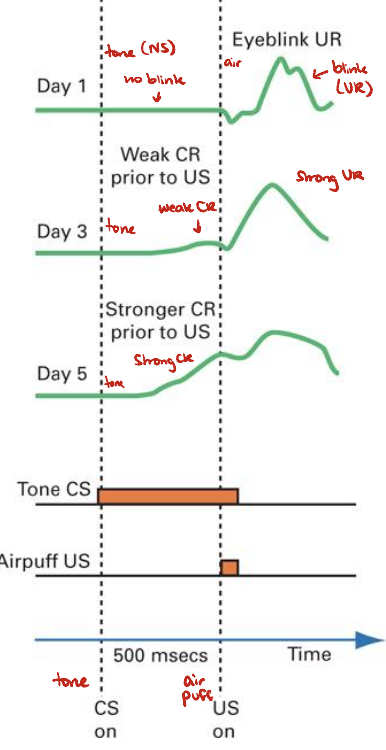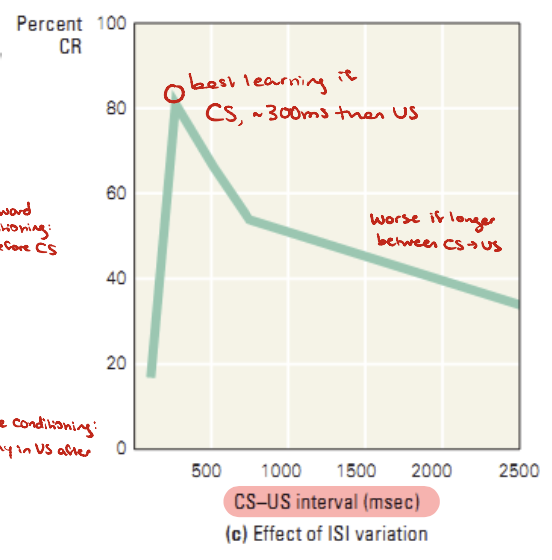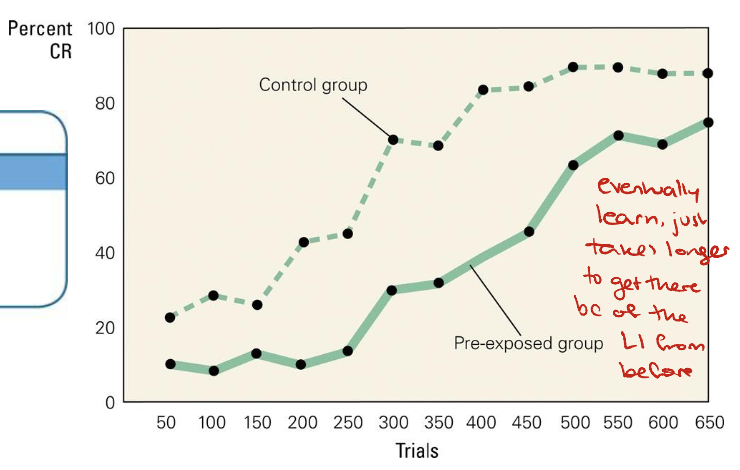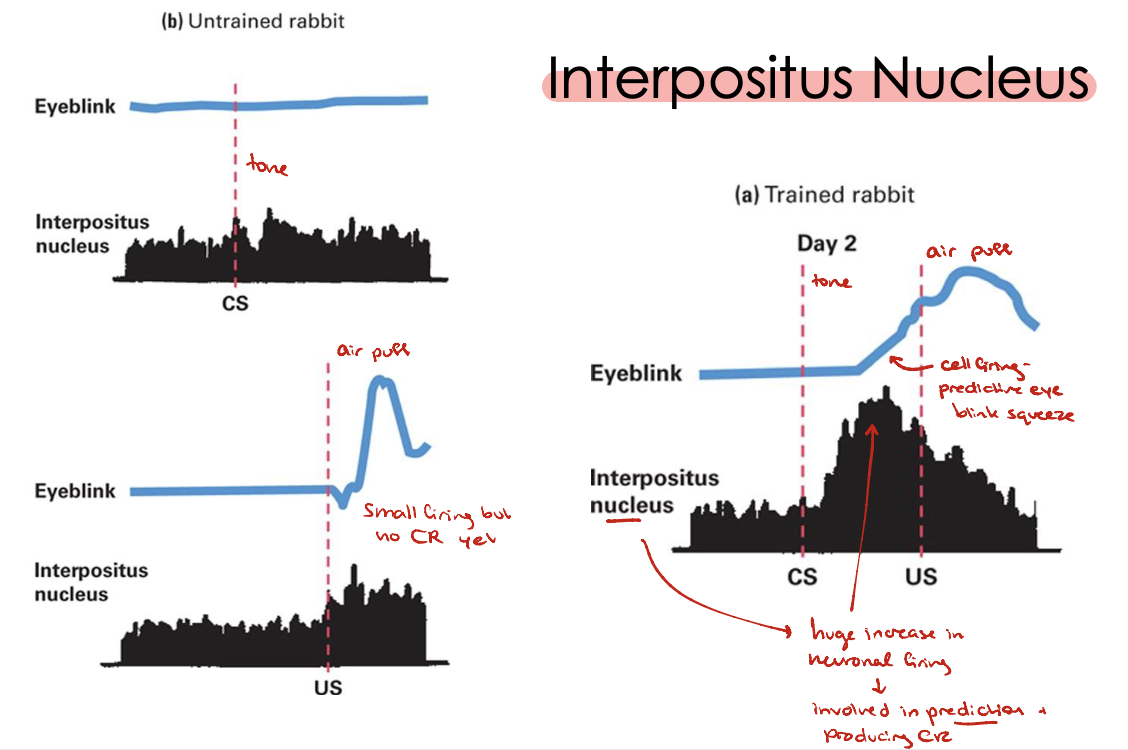PSY260 Lecture 4: Classical Conditioning
1/28
There's no tags or description
Looks like no tags are added yet.
Name | Mastery | Learn | Test | Matching | Spaced |
|---|
No study sessions yet.
29 Terms
Classical Conditioning (aka Pavlovian conditioning)
Begins with an innate (unlearned) reflex
Unconditioned stimulus (US) - food
Unconditioned response (UR) - salivation
US → UR response does not need to be conditioned, it is innate
A neutral stimulus (NS) [bell] is then repeatedly presented with the US → produces a new reflex
NS becomes CS (bell)
CS can now elicit CR (salivation)
Bell ringing → dog salivates before food is even presented
Classical Conditioning: Reasoning
Helps an organism prepare for the future
Bell triggers behaviours to prepare for the food
Classical conditioning represents an association between US and CS
Chance to test Aristotle’s principles of association
Contiguity: same time/spatial location
Similarity: similar stimulus may elicit same CR (slighty different bell may still elicit salivation) → proportional to similarity of stimulus
Frequency: ↑ frequency of association → ↑ strength of association
Appetitive Conditioning
When learning helps predict something good or appetizing
Elicits approach behaviour
Ex. Quail Sex Conditioning
Exposure to female (US) → innate approach behaviour (UR) in male quail
NS = tone/light → becomes CS
After pairing US with CS, CS starts to produce CR
Male quail approaches light before female even shows up
Aversive conditioning
New CS → CR reflex helps avoid noxious US
Elicits avoidance behaviour
Ex. fear conditioning → CR is unpleasant so you avoid it
Ex. Fruit Fly Fear Conditioning
Exposure to shock (US) → innate escape/avoidance behaviour (UR)
NS = odour → becomes CS
After US is paired with CS, CS starts to produce CR
Works with only 1 trial
Flies move away from odour chamber before shock
Eyeblink Conditioning
Puff of air to eye (US) → eyeblink (UR)
Innate (no conditioning needed)
NS → CS = tone/light
Gradually comes to produce an eye closure (CR)
CR is in anticipation of air puff (unpleasant)
Aversive conditioning: CS → CR prepares to avoid aversive US
CR = eye blink to avoid US = air puff when seeing CS = tone/light
Works on rabbits and humans but takes many trials
Eyeblink Conditioning: Steps
Initially, NS (tone) → no response
NS paired with US (air puff) → UR (eyeblink)
NS becomes CS → produces CR (eyeblink) even without US
Note: CR eyeblink is in anticipation of US (flinch) while UR is after airpuff (reflex)
Eyeblink Conditioning: Trials

Eyeblink conditioning: Timeline
Day 1: initially, NS does not produce any response
After extensive training, CR emerges as a slow squeezing shut of the eye before US (air puff)
CR is similar to UR but not the same → CR is anticipatory but both are blinks
Other cases: CR can be very different from UR

Conditioned Compensatory Response
CR that is the opposite of the UR, helping to balance/correct for the US-UR response
Overcorrection to maintain homeostasis
Body tried to get ahead of UR by counterbalancing the other way
Ex. inject adrenaline (US) → HR increase (UR)
Repeate procedure in same testing chamber (CS)
Eventually, CS comes to produce a decrease in HR (CR) to maintain homeostasis → counterbalance against expected adrenaline injection
This is an unconscious process
Extinction
Breaking the association between the CS and US can extinguish the new CS → CR reflex
Present the CS alone repeatedly
Initially, CS → CR link is strong
Repetition: CS becomes less effective and association weakens
Extinction probably doesn’t erase the CS-US connection, just inhibits it (inhibitory neurons)
Stress, new context, passage of time → can make the CS effective again
Easy to “wake up“ extinguished association
This suggests that the classically conditioned memory survives extinction
Rules of Classical Conditioning
Timing
Blocking
Latent inhibition
Associative bias
Timing
If the US precedes the CS → no learning
Backward conditioning
Ex. eyeblink: if you puff air before tone → not effective, no preparation
Best learning: CS then US very quickly
Ex. eyeblink: tone then puff immediately
Worse learning: CS then US at a delay
Trace conditioning

Trace conditioning
Delay in US after CS
Results in worse learning
More difficult to form association
Blocking
Previously learned association can block the formation of a new association
Similar to proactive interference (old blocks new)
Ex. Kamin’s Blocking Paradigm in rats
Control: trained to tone+light CS → shock US
After, both tone and light alone produce moderate CR (freezing)
Pre-trained: trained with just light CS → shock US
Then, same tone+light CS → shock US training
After, light produced large CR and tone produced none
Tone wasn’t providing any new info that light hadn’t already provided
Tone learning blocked by previous light CS → shock US association
Indicates that classical conditioning is about tracking information in the environment
When CS is redundant to what is already known → no new learning
No new info → no new learning
Latent Inhibition
First, pre-expose animal to NS/CS repeatedly
Ex. eyeblink = only tone, no air puff
No learning happens - animal learns that NS is not important
If you then pair NS/CS with US, learning is inhibited
Lag in learning because animal learned that NS doesn’t mean anything and stopped paying attention
Later overcomes this lag and is able to learn association, just delayed

Associative Bias
Some associations are innately easier to make:
Tone vs. taste paired with poison: only taste provokes CR
Tone vs. taste paired with shock: only tone provokes CR
In nature, tastes go with getting sick, sounds with getting hurt
Seems we have some innate preferences for forming associations that can override statistical correlations
Models of Classical Conditioning
The rules for classical conditioning are quite complex
Researchers have turned to models of classical conditioning - formal sets of rules for when learning will occur
Mismatch between model and data provides clues to what we still need to understand
2 popular traditions in models of classical conditioning:
US modulation approaches - Rescorla-Wagner
CS modulation (attentional) approaches - Mackintosh
US Modulation Theory: Rescorla-Wagner
Learning from errors
The amount of learning depends on prediction error: how much reality differs from expectation
↑ prediction error → ↑ learning
Is the US totally unexpected?
Large prediction error → lots of learning
Is the US accurately predicted by the CS?
No prediction error → minimal learning
BASICALLY: learning only occurs through failure of your expectations
Rescorla-Wagner Model: Math
Each stimulus has a weight (W) for predicting a US
Weights go from 0 (NS) to 1 (certain)
Sum of the stimulus weights is the animal’s prediction
Accumulation
When the predictino is wrong, the weights are adjusted
Error: difference between expected and actual outcome
Prediction error: actual US - expected US
Adjustment: each active stimulus adjusted by a proportion of Error
Change in stimulus weight: Learning rate x Prediction error
When error is 0 = no learning occurs (asymptote) → means that W = 1.0 and what you expected was already true
Rescorla-Wagner Model: Blocking
Can be used to explain blocking
Blocking study:
tone+light CS → shock US
light CS → shock US then tone+light CS → shock US (only light elicits CR)
RW: second stimulus adds no new info
No/low prediction error once association with the initial CS is learned, so no real need to learn about the new CS
CS Modulation Theory: Mackintosh
Proposed that CC focused on attention and the way the CS is processed
Stimuli have a salience → determines attention
Amount of learning depends on salience and relevance of CS
Cues that are better predictors warrant greater attention and have higher associability as a result
Ex. bell is previously paired with food: bell has high salience and should be paid attention to (you’ll get food!)
BASICALLY: how much attention each stimulus should be paid (salience)
Mackintosh Model: Latent Inhibition
Can be used to explain latent inhibition
Repeated exposure with no consequences → decreases salience
Form of habituation
Pre-exposure to CS decreases attention for that stimulus
Makes the CS harder to learn about in the training phase (reduces associability)
Mackintosh Model: Associative Bias
Some stimuli have more salience when it comes to certain outcomes/effects
Recall that taste/smell is highly associable with sickness/poison
Tone is more highly associable with physical pain
Brain subtrates
Since Pavlov, there has been interest in understanding how classical conditioning works at the neural level
1980s: Thompson and colleagues discovered that eyeblink conditioning in rabbits depends on cerebellum
Cerebellar substrates
CS-US association may be stored in:
Cerebral interpositus nucleus
Site of association between CS and US
Purkinje cells of cerebellar cortex
Carry signals related to discrepancies between expected and actual outcomes
Influence timing and magnitude of eyeblink CR
Recordings from cerebellum before/after learning help demonstrate where the memory is stored
Interpositus Nucleus
We see huge increase in neuronal firing during period between CS and US
Involved in prediction of US and production of CR

Purkinje Inhibition of Interpositus Nucleus
Inhibitory fibres
Well-trained animals: Purkinje cells switch OFF in response to CS
Shutting off Purkinje inhibition of interpositus nucleus → enables CS to generate CRs
Purkinje fibres OFF: CS → CR ON

Hippocampus
Removal of the hippocampus (with medial temporal lobe)
Treatment for epilepsy
Doesn’t alter basic classical conditioning paradigms
Eliminates latent inhibition and trace conditioning
Plays an important role in processing/binding contextual information
Ex. context fear in fear conditioning → the room you’re in, who’s involved etc
Gives valuable info to predict something scary
Where is Conditioning Taking Place?
We don’t have a single clear answer, and there seem to be many areas working together
Maybe:
US modulation (Rescorla-Wagner) occurs in cerebellum
CS modulation (Mackintosh) occurs in hippocampus and medial temporal lobes